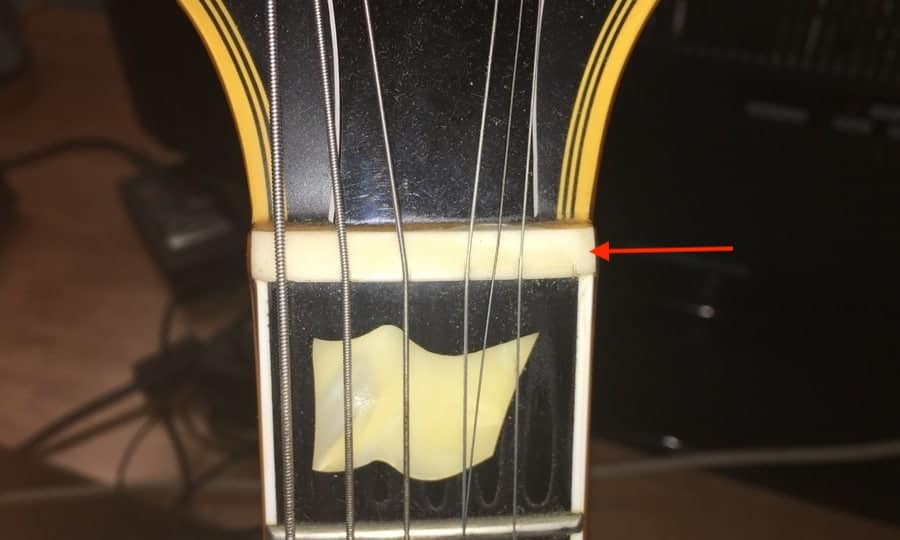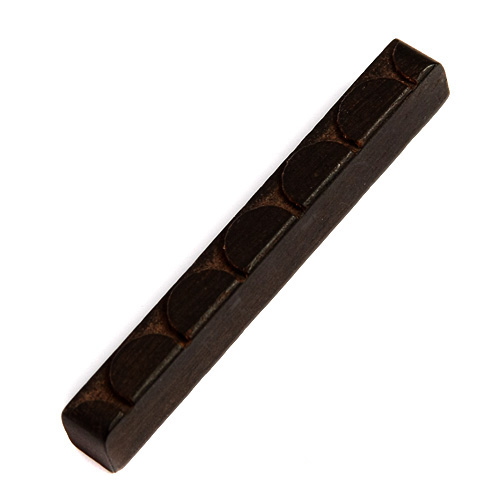There are many parts of a standard electric and acoustic guitar, and each one serves an entirely different purpose. Chances are that if the manufacturer put something on the instrument, it’s there for a reason.
One part of the guitar that’s absolutely critical to the instrument is the nut, which is located at the point where the neck ends and the headstock begins.
A guitar nut is a small piece of material – usually plastic, bone, or graphite – with small slits cut into the material which is meant to securely hold the guitar strings where the neck ends and the headstock begins.
The nut is a very small but important piece of what makes a guitar function properly. Additionally, the material that it’s made out of determines how the instrument will sound.
The guitar’s strings always sit in the nut, and it’s constructed in such a way where the strings can reverberate as normal without being thwarted by the nut.
You can see what a standard nut looks like in the image below:

It’s commonly argued that the guitar nut has a big impact on the guitar’s playability, tone, and general performance. The nut can impact the tone of the instrument either negatively or poorly, depending on what it’s made out of and how it’s been set.
And there are many different types of guitar nuts as well, including some of the materials mentioned below.
Types of Guitar Nuts
1) Plastic

Plastic guitar nuts are arguably the most common because plastic is the cheapest material. Manufacturers can make plastic nuts for a fraction of what a bone or an ivory nut would cost.
According to Pro Audio Land, superior plastic nuts are commonly constructed out of Micarta or Corian, and while they’re able to serve the function for which they’re intended, the sound quality isn’t as good as other materials because plastic isn’t conducive to sound.
However, Micarta and Corian are noted for being slighter better than other types of plastic. Most technicians and experts on the subject state that plastic is the worst quality of nut due to its sound quality.
Due to their relatively low cost, plastic nuts can be seen everywhere in the world of guitar manufacturing, although, they’re typically on the cheapest models.
Even though plastic nuts aren’t the best, there are some high-end plastics that are superior to much cheaper plastics, including TUSQ, which has been created to mimic bone without the supposed inconsistencies.
TUSQ, like graphite, is also self-lubricating and it has great tuning stability which is also easier to shape to fit the strings.
2) Metal

There are many different types of metal nuts, including brass, titanium, steel, and more.
The main advantage of using a metal nut is the brightness as well as the durability.
If you use a metal nut, whether it’s titanium, brass, or steel, you can expect it to last a very long time.
Regarding the tonal properties, the sound is much brighter and it’s typically meant for bluegrass or country-style instruments, especially acoustic guitars.
According to Zing Instruments, nuts made out of metal do sound much better than plastic, but they’re not nearly as good as bone or fossilized ivory. Metal nuts are typically used for a specific purpose. They tend to be less versatile because of their brightness.
A metal nut will almost never be a problem for guitar players who are just starting to learn, but more experienced players may tend to avoid them because the tone may not match what they’re looking for.
At one point in time in guitar history, brass nuts were incredibly popular, and guitarists in the 1970s commonly used them, however, as cheaper materials became available, they quickly went out of style.
Regarding the electric guitar, some like to use a brass nut with heavy overdrive, because the way the string reverberates on the brass nut tends to be much brighter and more defined when using a lot of overdrive or distortion.
3) Bone

Bone nuts are often described as the greatest material for nuts. It’s not uncommon to find this style of nut on guitars created by the most reputable manufacturers, including Fender, Gibson, and Martin.
Bone is known for being quite bright, but not as bright as metal. Bone tends to be conducive to sound, which makes it great for housing the strings between the neck and the headstock.
One of the main drawbacks of using bone, however, is the fact they can be inconsistent in terms of the structure of the material.
For instance, bone nuts can have small pockets within the material, due to the fact it’s a naturally occurring material, rather than being constructed through a manufacturing process.
With that said, some luthiers argue that the inconsistencies of bone guitar nuts are a myth. For instance, Bob Colosi, who is a luthier who specializes in making parts for the guitar, claims that the idea of a bone nut being inconsistent isn’t true.
He argues that bone nuts are only inconsistent if the manufacturer used a lower quality product.
Despite it’s supposed drawbacks, bone nuts are known for being conducive to tonal quality, and luthiers love to work with them because they’re easier to cut and shape to fit the guitar and the guitarist’s needs.
Pro Audio Land says bone nuts are easier to shape when angling, slotting, or for choosing the appropriate amount of string relief. These are all significant things to take into consideration when crafting a nut, and more importantly, when choosing which material to use.
Furthermore, bone is self-lubricating, which means they tend to stay in tune longer, and it’s also great for the B-string, which is commonly the string that goes out of tune the easiest.
On account of its self-lubricating quality, the strings can quickly go back to form after withstanding strong bends or vibrato.
4) Graphite Nuts

Graphite nuts are another popular choice when creating nuts. The primary advantage of using a graphite nut is the fact it also self-lubricates so there isn’t as much friction as other materials like plastic or steel.
Graphite nuts are known for having fantastic tuning stability and also for the tremolo. On the other hand, graphite nuts that are much cheaper tend to have less of the same quality.
It’s not uncommon for guitarists to actually use the graphite material in a pencil as a lubricant for their guitar nut.
Explained in another way, guitarists will take the strings off their instrument, shave off a bit of graphite from the pencil, and then rub the graphite into the nut slot.
From there, they put the strings back on and it supposedly acts as a temporary lubricant.
5) Ebony

Ebony is often used for guitar nuts as well, and they have the reputation for looking cool and also sounding great (my other guide on the purported universality of nuts).
It’s commonly argued, however, that ebony nuts tend to soften quicker than the other materials.
Where Do I Find Guitar Nuts?
Most music stores have guitar nuts in stock, however, if you want a specialty nut, like one crafted out of bone or some other nuanced material, you may have to search somewhere online.
Furthermore, you can find nuts and other equipment at Guitar Parts Resource. They have a long list of items and nuts available for a reasonable price. Access their website here.
How Much Does A Guitar Nut Cost?
The good thing about nuts is the fact they’re relatively inexpensive, even if you’ve chosen to purchase the most expensive one available.
Guitar nuts can cost between $1 and $20, however, it’s more common for them to cost around $7-$10.
| Types of Guitar Nuts | Average Price | Description |
| Plastic | ~$7 | Plastic Nuts are easily the least expensive out of all of the nut types, as well as the most common |
| Bone | ~$7-$15 | Bone nuts are often held as the gold standard of guitar nuts. It’s commonly stated that bone is the easiest material to work with. |
| Ebony | ~$7-$10 | Similar to bone nuts, ebony nuts have a reputation for sounding great and being easy to work with. |
| Brass | ~$15-$30 | Brass nuts are known for being much brighter in tone. They were more popular in the 60s and 70s. |
| Titanium | ~$15-$25 | Another type of metallic nut. Brass and titanium tend to cost more. They’re more reliable but more nuanced in terms of their tone. |
| Graphite | ~$8-$15 | Known for a solid sound and being self-lubricating. Tend to wear out sooner, however. |
Important Things To Note
Ostensible Difference in Sound Quality
Much of the tonal and sonic quality of guitar nuts and saddles are still up for debate.
For example, Bob Colosi argues that nuts don’t actually affect the sound quality of the instrument that much unless it’s for open strings.
What Is The Best Material For A Guitar Nut?
It’s commonly argued that bone is the best material for making a guitar nut for a number of reasons.
One such reason is that bone tends to be the most conducive to superior sound quality, and the other is that bone is easiest for the luthier to work with and shape.
Some people argue that bone can have inconsistencies within its structure, however, other luthiers say this depends more on the quality of the bone and whether the manufacturer used proper materials.
How Do You Fix A Guitar Nut?
Getting A Luthier to Install The Nut
Most manufacturers will recommend getting a luthier to shape and install a nut for you, although, some people might choose to do it themselves.
If that’s the case, it’s as simple as heating up the glue underneath the nut which will allow for it to be removed. To place the nut, you just have to add adhesive to the bottom of the nut and then place it onto the headstock. From here, you just have to wait for the glue to dry.
YouTube Video Tutorial
Conclusion
While a nut seems like an unimportant part of the guitar, it’s a crucial component. They come in many different materials, and they’re fundamental for holding the strings in place between the neck and the headstock.

 Written By :
Written By :